HOOKING UP WHILE HAUNTED BY AN EX IN PHOBIA
by Thomas M. Sipos, managing editor [July 18, 2014]
[HollywoodInvestigator.com] It's hard dating someone new. Even harder if your ex-wife won't let go. And still harder if she's dead and won't stop haunting you. That's Jonathan's (Michael Jefferson) predicament in Phobia. His wife Jane (Sarah Schoofs) died last year in a car accident, on their way home from a party that she didn't want to attend. Now Jonathan blames himself for her death. So much so that he's developed agoraphobia and can't leave his Brooklyn brownstone.
Then, just as he starts forming a relationship with Bree (Emma Dubery), the grocery delivery girl, he starts seeing menacing people inside his house. A creepy woman with spider legs. A burglar with a knife. His dead wife. Are they demons, ghosts, spirits -- or is Jonathan losing his mind?
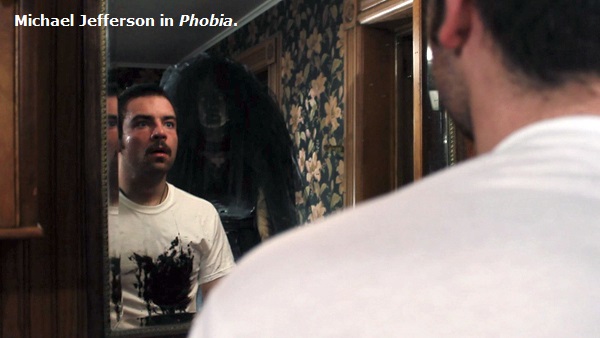
Director Rory Abel met Phobia's co-writer while working on a "a horror comedy web series" for NBC Universal's digital dept. "Unfortunately, the department was shuttered before we began production. Matthew suggested we focus on a feature film. I had been playing with the idea of a schizophrenic who might be hallucinating or encountering real monsters. Since we would be working with a limited budget and few locations, we decided, instead of schizophrenia, to go with agoraphobia. Matthew wrote the first draft and the next several. When I took over the rewrites, it was to smooth out some plot elements and character motivations. I added several elements, including two new characters.
"When it came to influences, it was more about looking at other haunted house movies and deciding what elements to avoid using, rather than what to emulate. The agoraphobia was useful to avoid the convoluted means that many horror films resort to in order to keep their protagonists in the house. Our lead didn't leave because he couldn't.
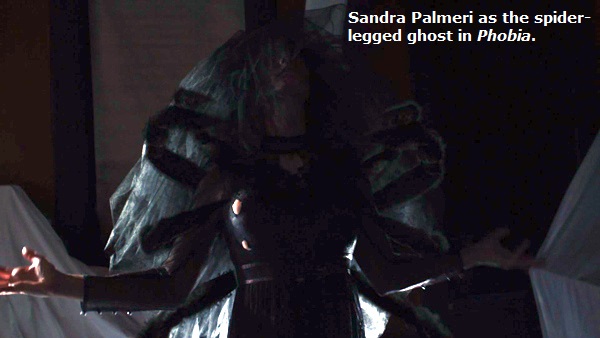
"Ironically, I changed our main antagonist's gender to female because I felt its original appearance, the dark-suited man, was too familiar to horror fans. Then only two weeks into production, the first publicity photo for Insidious came out. What's it of? A woman in a black wedding dress (above), just like our villain. Sometimes you can't win."
Phobia is nicely photographed Mike Aransky, whose lighting conveys both mood and Jonathan's psyche. When Jonathan opens the front door, glaring light overexposes the image, suggesting his panic upon being over-powered by the great outdoors.
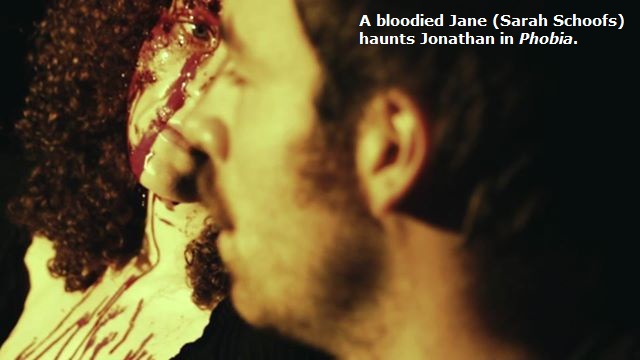
These occasional bright flashes from open doorways and windows contrast with the house's dim interior, whose murky shadows support a tale that relies largely on mood and insinuation. We're supposed to wonder -- Is Michael psychotic or haunted? My bet was on psychotic. There seems to be no consistent motivation behind the hauntings. Sometimes Michael sees Jane, sometimes the knife-wielding intruder, sometimes the spider lady in black wedding dress. They appear and vanish and come again, but don't actually do much of anything. They seem to be the usual horror shocks meant to jolt audiences. They begin to bore once we realize they can't, or won't, hurt Jonathan.
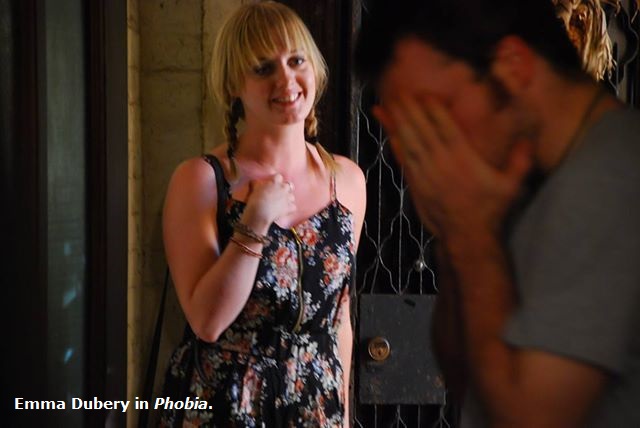
What prevents Phobia from becoming a total bore are not its scares but its love story. Jonathan is engaging enough to maintain our interest. We care about his budding relationship with Bree. We worry that his growing insanity will drive her off -- or even endanger her. Despite its shocks and shadows, Phobia feels less like a horror film than a New York indie film about young singles hooking up. Only instead of the usual Sex and the City impediments to their potential couplehood, Jonathan sees dead people.
The film's title was changed from Alone to Phobia on advice from a distributor who thought Phobia sounded more like a horror film. I don't see that one title says "horror" more so than the other, but such are the thoughts of distributors.

Phobia's sound is professional, despite some obvious dubbing in one scene. More importantly, the sound mix aesthetically supports the events onscreen. When Jonathan opens the front door, the brightening light is matched by a corresponding increase in volume, further conveying Jonathan's fear of the outside world.
While not an especially scary film, Phobia benefits from a strong and experienced cast, including a cameo from cult horror actress Debbie Rochon.
"One advantage of being in New York is there are a lot of actors to pick from," said Abel. "We used two websites, Mandy and New York Casting, as well as recommendations from other directors. Michael Jefferson was found through Mandy.
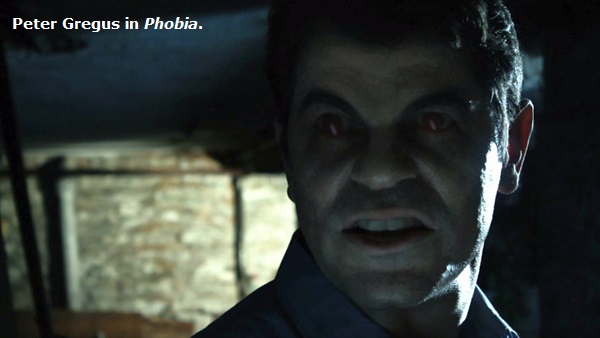
"Sarah Schoofs had starred in Gut, a film one of our producers, Elias Ganster, directed, so I had seen her performance. We were very lucky to get Peter Gregus. [Jonathan's therapist.] He’s been appearing on Broadway in Jersey Boys for years now. Scheduling him was a nightmare since we had to work around his Broadway schedule.
"A friend of our production manager, a casting director, was kind enough to sit in on some auditions and make recommendations. Otherwise, we, the producers, did all the auditions and callbacks. We held four days of initial auditions and saw around 70 actors. The callbacks were held in pairs so we could see how certain actors played off of one another. We did that in a single evening.
"Debbie Rochon was added to the cast much later in the production than the other actors. When we decided that we wanted a known horror actor/actress in the film, we reached out to a few who were receptive to indie productions. Debbie has appeared in all the Bikini Bloodbath films, directed by my friend Thomas Edward Seymour. He was put us in touch with her. We had to delay the final day of shooting by two weeks so we could fit her in. The day before she arrived on set she had been in Canada filming a different film."
It's a fine cast. My only problem is that I initially thought Schoofs and Palmeri were the same person. The actresses share a similar body type, and because Palmeri is often lost in shadows, seen only in brief shots from a distance, we see nothing distinctive about her. It wasn't until Jonathan tells Bree about the strange woman he's been seeing that I realized that she was not Jane.

Phobia was shot on a Canon 7D, the same model Ganster used for Gut. "I was impressed with what it was able to deliver," said Abel. "Its price was low enough that we could afford a greater amount of equipment. In retrospect, it had its drawbacks. Because the lens were intended for still photography, the focal ring only requires tiny adjustments when racking focus, so it was sometimes hard to hit our focal marks. The moiré issue also proved to be a problem. One of the shirts our lead wears looked fine during camera tests, but produced moiré patterns once we were filming." The film was edited on Final Cut 7.
Like many low-budget horror films, Phobia was kept to a single location. "The house belongs to our producer Glenn Abel," said Rory Abel. "Yes, the last name is significant. He was kind enough to give us free reign of the house. Once I confirmed that I would be able to use the house, it was Matthew's idea to keep the film confined there. However, the decision wasn't made entirely because of budget. A single location simplifies a production in a lot of ways. That was important, since this was my first time producing or directing a feature."
Phobia reportedly cost $150,000 to make. "The budget was raised through a combination of online fundraising, maxed-out credit cards, and in-kind donations of equipment and resources," said Abel. "There was a lot of begging and groveling." His advice for other low-budget filmmakers: "Be realistic about your abilities and resources. Tailor your script to your resources. While he was writing the first draft, I sent Matthew photographs of the rooms and a floor plan, so he understood what could be realistically pulled off in the house.
"Strive to make things bigger and better, but understand your limitations. Even with how simple and stripped down our film proved to be, there were still elements beyond our abilities once we were on set, and had to be exorcized from the film. If we had realized this during pre-production, time and money could have been saved."

Phobia debuted at the Drunken Zombie Film Festival last year. It's currently in submission to other horror film festivals. Abel says that Ruthless Pictures recently "picked up our North American rights. Their CEO, Jesse Baget, a genre filmmaker himself, knows how to get our film out there. He is currently locking in distribution for us. We'll have some big announcements in the near future."

|
